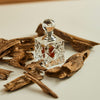

Yes, mould plays a key role in making oud. The process might sound simple—a tree infected with mould—but it’s far from that. Oud’s high price comes down to its rarity, craftsmanship, and unique character.
Oud begins as agarwood, a type of wood from Aquilaria trees native to Southeast Asia. Agarwood alone is uncommon, but only about 2% of these trees develop oud naturally. This happens when the tree gets infected by a specific mould, which triggers the production of a resin that transforms the wood. That resin-soaked wood becomes the source of oud.
Turning this resinous wood into usable oud is not straightforward. The wood is chipped, soaked, and then slowly distilled at low heat. This process is labor-intensive and requires a skilled hand to ensure quality. The effort and time involved add to its exclusivity.
Oud also matures with age. Like a well-aged wine, its scent profile changes over time. Aged oud can shift from sharp and spicy to softer, more leathery or smoky tones. This aging makes older oud oils and perfumes highly sought after—and more expensive.
Another reason for oud’s appeal is its interaction with your skin. The scent develops differently depending on your chemistry, creating a personal and distinct experience. Some enthusiasts even describe sensing “textures” or “colours” in the scent, adding to its mystique.
Ultimately, oud proves that something as unexpected as mould can create something rare, valuable, and deeply intriguing for those who appreciate it.


